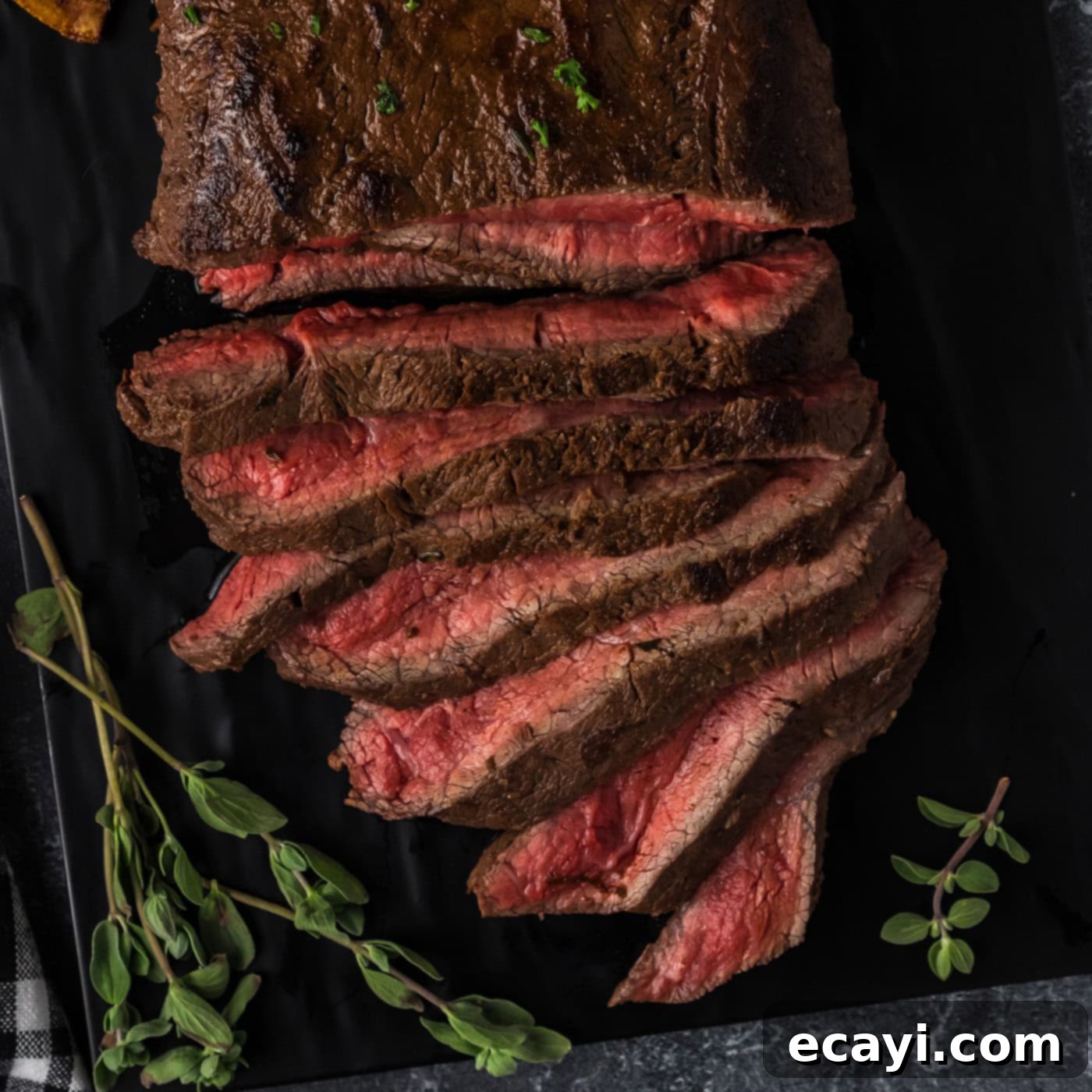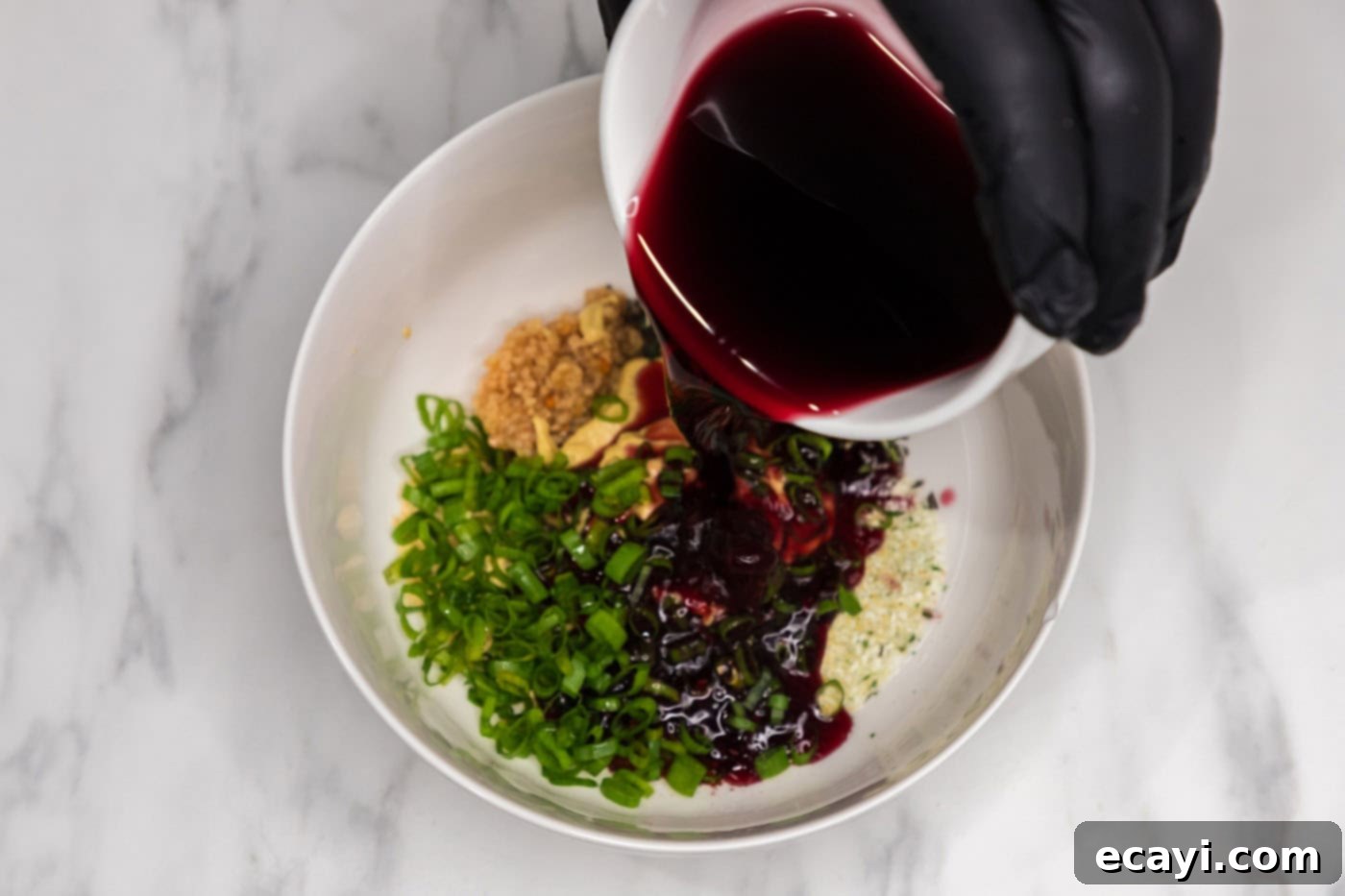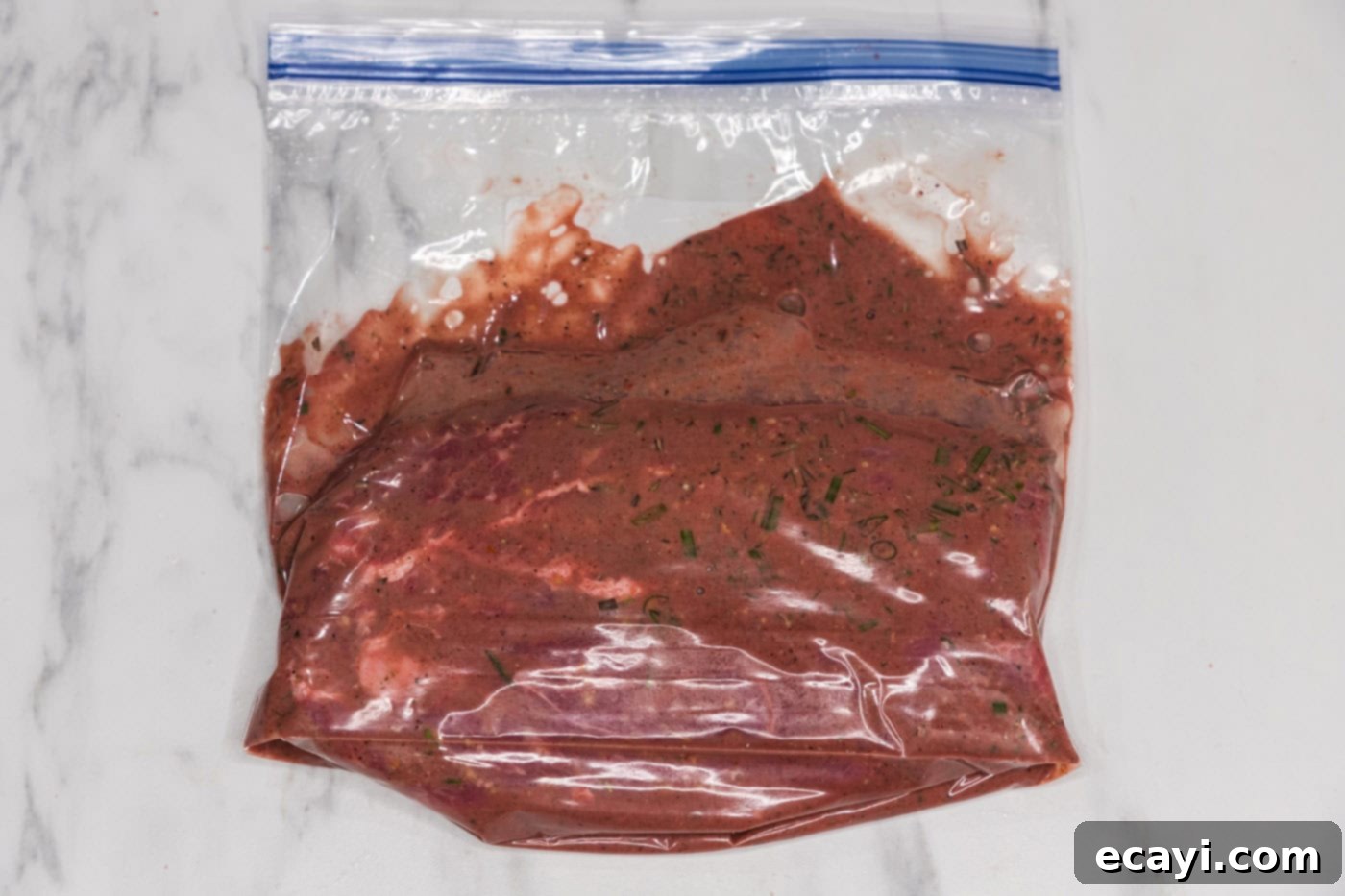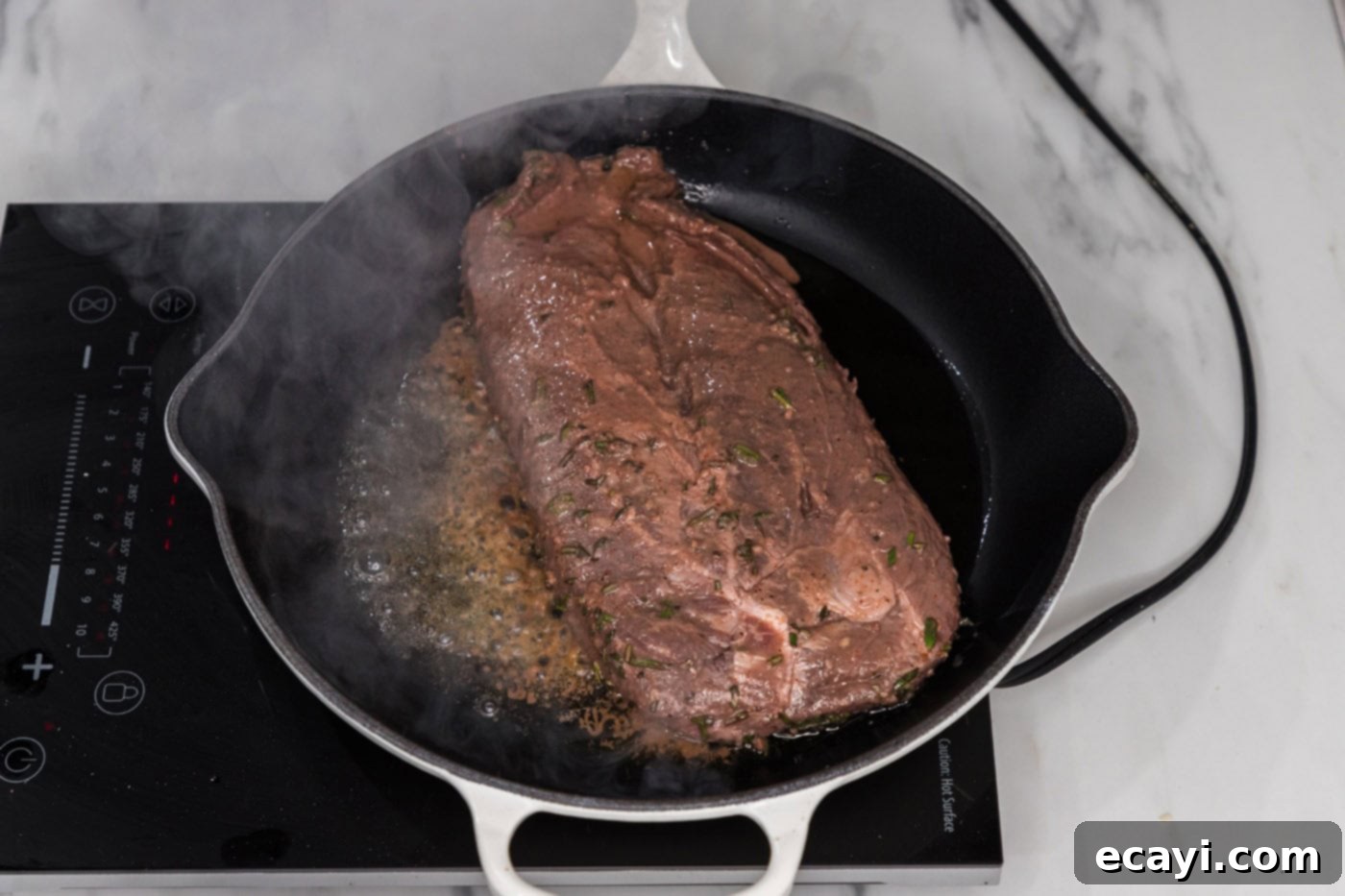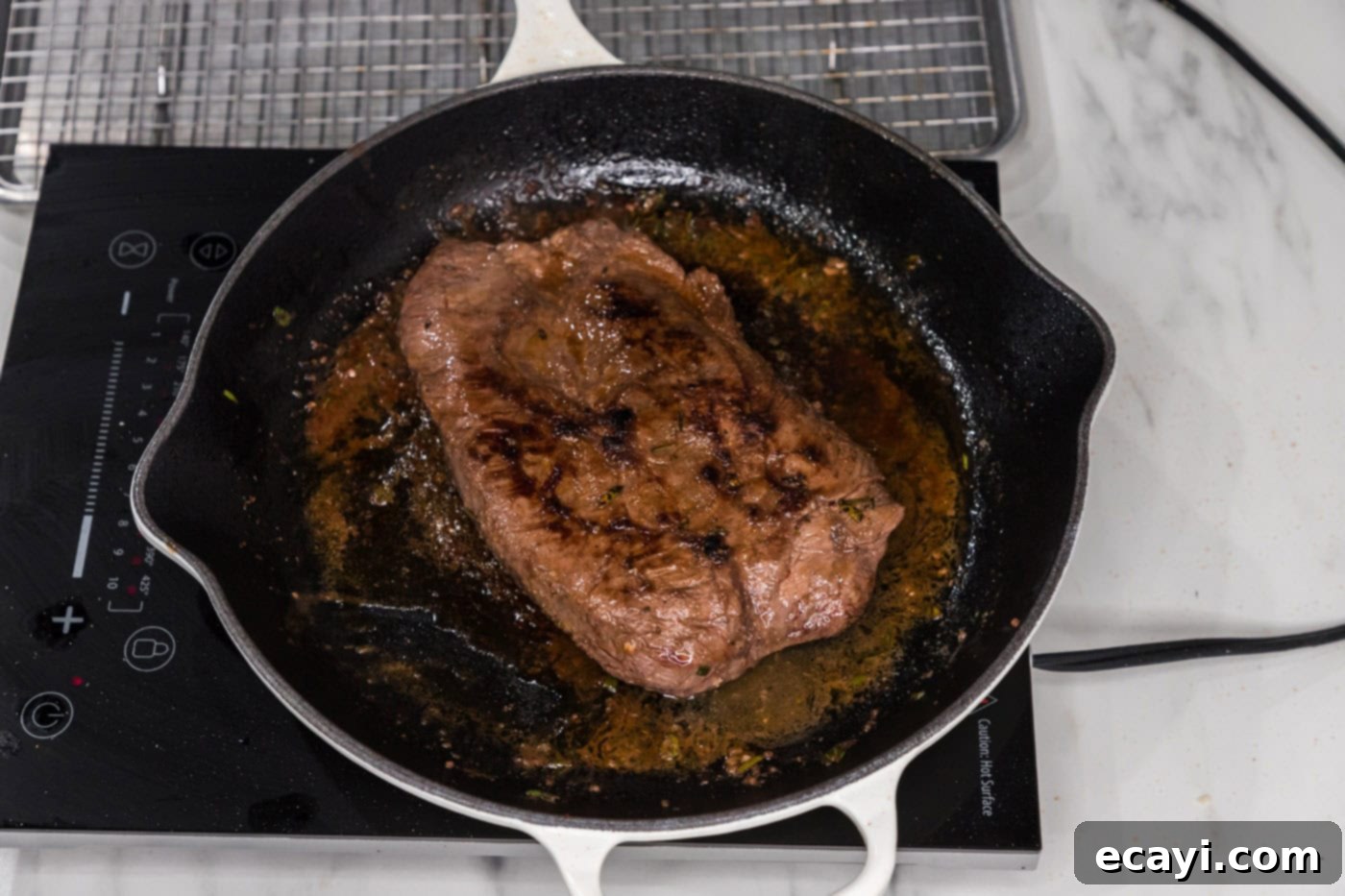Juicy & Tender Flat Iron Steak Recipe: Master the Garlic Rosemary Marinade for Pan-Seared Perfection
Prepare for an extraordinary dining experience with this elevated flat iron steak recipe. Infused with a robust garlic and rosemary marinade, each bite promises a symphony of deep flavors and incredible tenderness. The steak is quickly seared to achieve a beautiful, delicate crust, then skillfully transferred to the oven for an even, juicy interior. This method ensures perfection every time, making it a go-to for weeknight dinners or special occasions.
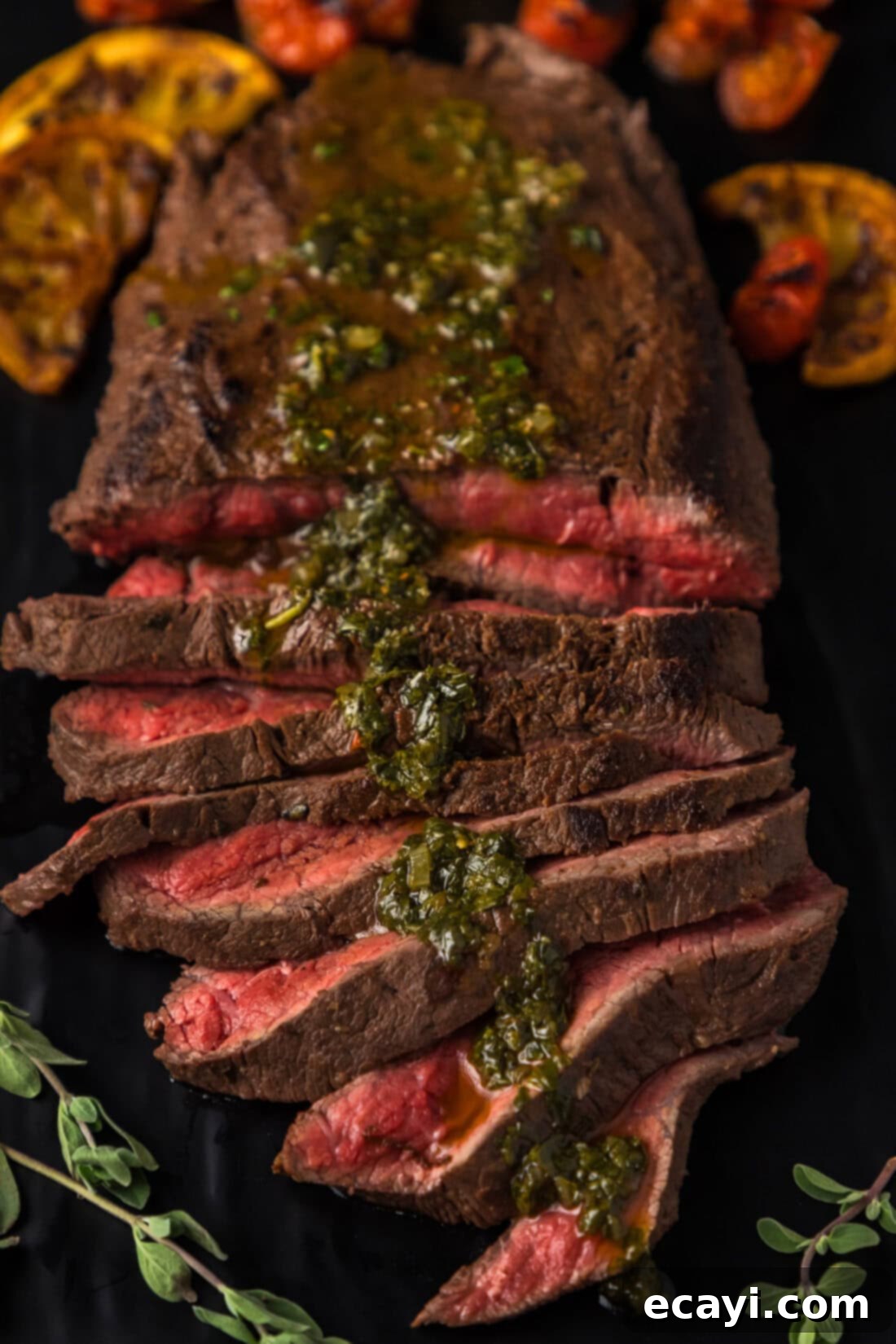
Why This Flat Iron Steak Recipe Works Wonders
Flat iron steak, often referred to as a “top blade steak,” is a truly remarkable and often underestimated cut of beef. Its inherent qualities make it an ideal choice for a show-stopping meal without breaking the bank. This recipe leverages these characteristics, along with a powerful marinade and precise cooking technique, to deliver consistently spectacular results.
What makes flat iron steak so special is its rich marbling – the intramuscular fat that melts during cooking, basting the meat from within and contributing to its incredibly intense, beefy flavor. When prepared correctly, this cut yields unbelievably juicy and perfectly tender results that rival much more expensive options. In fact, many culinary experts consider flat iron steak to be one of the most tender cuts available, second only to the highly prized beef tenderloin and filet mignon. This means you can enjoy a luxurious steak experience without the premium price tag.
The magic truly begins with our fresh herb, garlic, and red wine marinade. Soaking the flat iron steak in this flavorful mixture does more than just add taste; the acidity from the red wine works to gently break down muscle fibers, further tenderizing the meat and allowing it to absorb a deeper, more complex flavor profile. This infusion of savory garlic, aromatic rosemary, tangy Dijon, and a hint of sweetness from the wine transforms an already great cut into something truly exceptional. It’s a cost-effective way to achieve gourmet steakhouse quality right in your own kitchen, without compromising on any of the rich, satisfying flavor you crave.
Our specific cooking method – a quick, high-heat sear followed by a finish in the oven – is the secret to achieving that perfect balance of textures. Searing creates a beautiful, caramelized crust through the Maillard reaction, locking in juices and adding a layer of savory depth. Finishing the steak in the oven ensures that the heat penetrates gently and evenly, preventing the exterior from overcooking while the interior reaches your desired level of doneness, from a blushing medium-rare to a perfectly cooked medium. The result is a steak with a satisfying exterior crust and an unbelievably juicy, tender center. And for an ultimate flavor boost, serving it with a generous scoop of vibrant chimichurri on top elevates this dish to an art form, adding a fresh, herbaceous counterpoint to the rich beef.
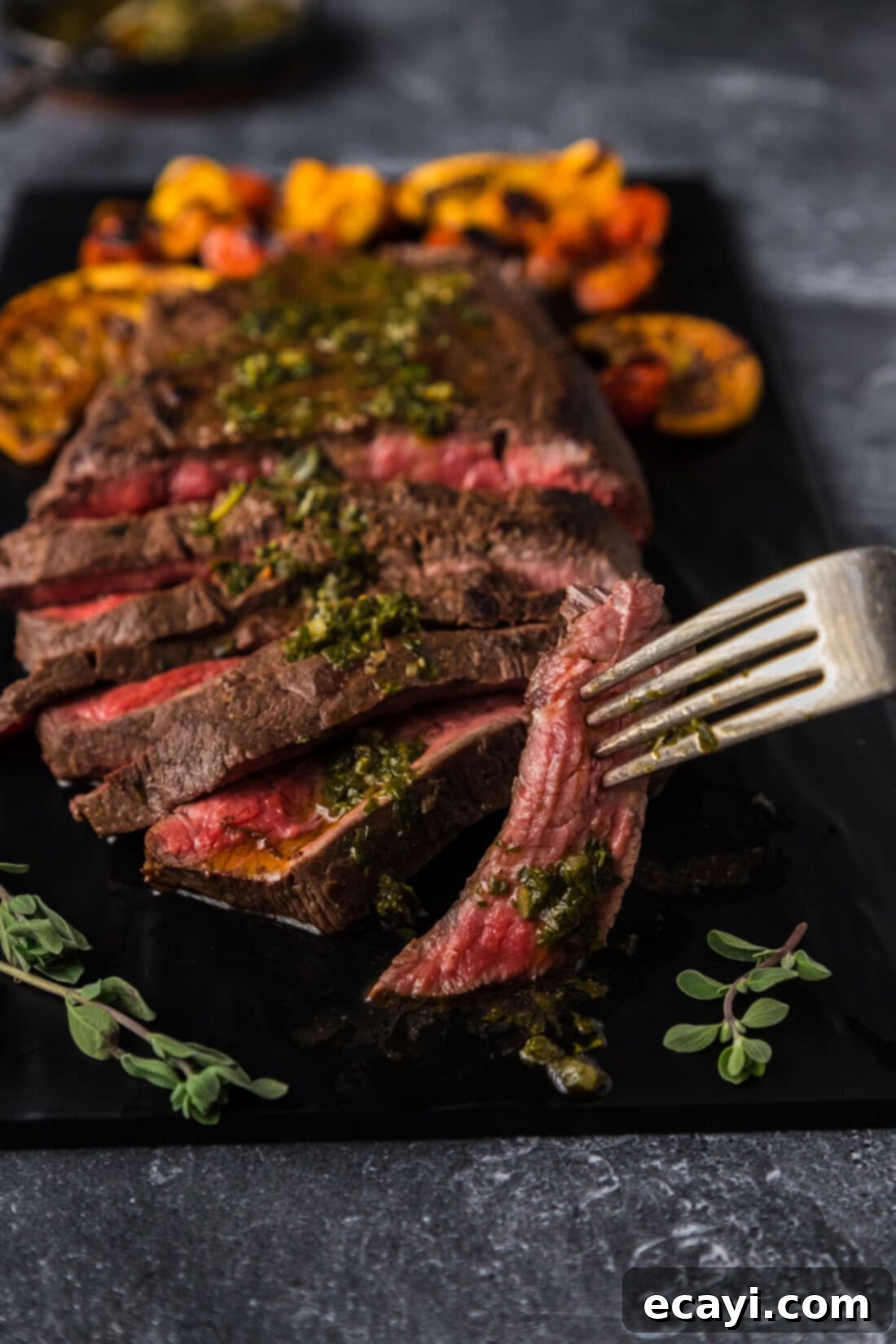
Essential Ingredients for Your Flat Iron Steak
To recreate this sensational flat iron steak, you’ll need a selection of high-quality ingredients for both the steak itself and its transformative marinade. Gathering all your components beforehand, a practice known as “mise en place,” will ensure a smooth and enjoyable cooking process. You can find all specific measurements, ingredients, and detailed instructions in the printable recipe card located at the end of this post.
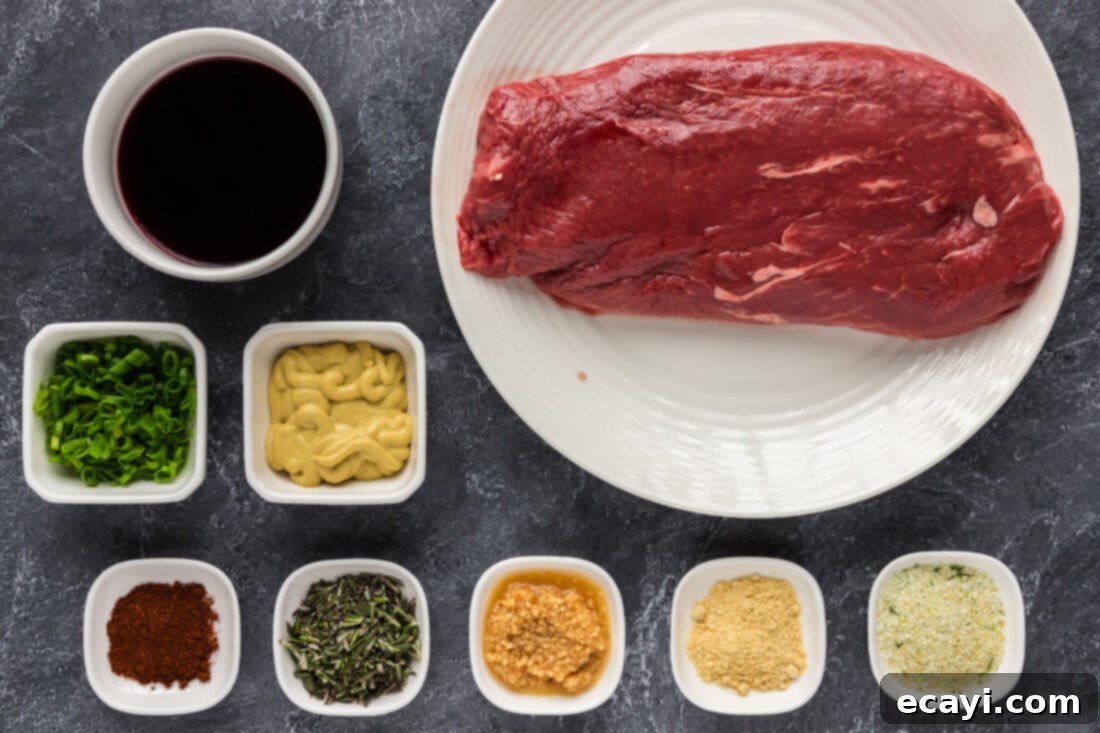
Ingredient Spotlight & Smart Substitutions
Understanding the role of each ingredient will help you achieve the best flavor and allow for informed substitutions if needed.
STEAK – The star of our dish is the flat iron steak, also known by butchers as a “top blade steak.” This particular cut of beef is taken from the shoulder primal of the cow. It’s renowned for its impressive tenderness, often compared to the much pricier tenderloin, thanks to its excellent marbling and the way the muscle fibers are arranged. For optimal searing and crust development, it is absolutely crucial to pat the meat thoroughly dry with paper towels before it hits the hot skillet. Excess moisture will steam the steak rather than sear it, preventing that coveted crispy, flavorful exterior. When selecting your flat iron steak, look for good marbling and a uniform thickness if possible, as this will help ensure even cooking. The steak typically comes as a single, relatively thin piece, often with a visible line of connective tissue that has usually been removed by the butcher, making it uniformly tender.
MARINADE – The heart of this recipe’s deep flavor lies within its robust marinade. Each ingredient plays a vital role:
- Red Wine: A dry red wine, such as Cabernet Sauvignon, is paramount for this marinade. It serves multiple purposes: its acidity works as a natural tenderizer, gently breaking down the meat’s muscle fibers to ensure maximum tenderness. Beyond tenderizing, the wine infuses the steak with incredible depth and richness, adding complex, earthy notes and a subtle sweetness that perfectly complements the beef. Don’t feel obligated to open a whole bottle for this recipe; many grocery or liquor stores offer convenient single-serve containers or mini bottles of wine, which are perfect for marinades. If you prefer not to use alcohol, a robust beef broth combined with a splash of red wine vinegar or balsamic vinegar can be a good non-alcoholic substitute, offering similar acidic and rich undertones.
- Minced Garlic: Freshly minced garlic provides a pungent, aromatic foundation for the marinade. Its unmistakable flavor permeates the meat, adding a savory zest. For convenience, pre-minced garlic can be used, but fresh garlic offers a more vibrant taste.
- Fresh Rosemary: The fragrant, piney notes of fresh rosemary are a classic pairing with beef. It contributes an earthy, slightly peppery aroma and flavor that elevates the entire dish. If fresh rosemary isn’t available, dried rosemary can be used, but remember that dried herbs are more potent, so use about half the amount (e.g., ½ tablespoon dried for 1 tablespoon fresh).
- Dijon Mustard: Dijon mustard adds a tangy, slightly spicy kick and acts as an emulsifier, helping all the marinade ingredients blend seamlessly and adhere to the steak. It also contributes to the beautiful crust formation during searing. Whole-grain or spicy brown mustard can be substituted if Dijon is unavailable, though the flavor profile will shift slightly.
- Green Onion: Using the green part of the green onion adds a mild, fresh oniony flavor that brightens the marinade without overpowering the other ingredients. If green onions are out of reach, a very small amount of finely minced shallot or chives could work as a subtle alternative.
- Spices and Seasoning (Garlic Salt, Chili Powder, Dry Mustard Powder): These dry ingredients are critical for building layers of flavor. Garlic salt doubles down on the savory garlic notes while providing essential seasoning. Chili powder adds a touch of warmth and subtle smokiness, contributing to the marinade’s robustness. Dry mustard powder, distinct from Dijon, offers a sharper, more concentrated mustard flavor that enhances the beefiness and aids in browning. Feel free to adjust the quantities of these spices to your personal preference, adding a pinch more chili powder for extra warmth or a dash of black pepper for an added kick.
Step-by-Step Guide to Making Perfect Flat Iron Steak
These step-by-step photos and detailed instructions are here to help you visualize how to make this delicious recipe. For a quick reference, you can Jump to Recipe to get the printable version of this recipe, complete with precise measurements and condensed instructions at the bottom of the page.
- Prepare Your Oven: Begin by preheating your oven to 400 F (200 C). This ensures the oven is at the correct temperature for even cooking when the steak is transferred from the skillet, allowing for a gentle finish and preventing overcooking of the exterior.
- Marinating Bag Prep: Carefully place your flat iron steak into a gallon-sized zipper plastic bag. This makes the marinating process easy and clean, ensuring the steak is fully submerged in the flavorful mixture.
- Craft the Marinade: In a separate bowl, combine all the marinade ingredients: minced garlic, chopped fresh rosemary, garlic salt, chili powder, dry mustard powder, Dijon mustard, chopped green onion (green part only), and dry red wine. Stir them together well until thoroughly mixed. Once combined, pour this aromatic marinade over the steak in the zipper bag. Ensure the steak is completely coated by massaging the bag gently.

- Marinate and Rest: Seal the bag, pressing out as much air as possible. Place the steak in the fridge to marinate for a minimum of 3 hours, or ideally, overnight (up to 12 hours) for maximum flavor penetration and tenderization. About an hour before you plan to cook, remove the steak from the refrigerator and let it sit at room temperature. This crucial step helps the steak cook more evenly and prevents it from seizing up when it hits the hot pan. Before cooking, remove the steak from the marinade and pat it thoroughly dry with paper towels. This is essential for achieving a good sear and a crispy crust.

- Sear for a Perfect Crust: Heat olive oil in an oven-proof skillet (cast iron is excellent for this) over medium-high heat until it begins to shimmer and just barely smoke. Carefully add the dried steak to the hot skillet. Sear it on both sides for approximately 3-4 minutes per side. You’re looking for a deep brown, caramelized crust, indicating the delicious Maillard reaction. Resist the urge to move the steak too much during searing, as this interferes with crust development.

- Finish in the Oven: Immediately after searing, transfer the entire oven-proof skillet (with the steak still inside) to the preheated oven. Bake for an additional 5-10 minutes. Aim for 5 minutes for a medium-rare steak (internal temperature of 130-135 F) and 10 minutes for a medium steak (internal temperature of 135-140 F). Use a meat thermometer inserted into the thickest part of the steak for the most accurate results.

- Rest and Slice: Once the steak reaches your desired doneness, remove the skillet from the oven and carefully transfer the steak to a clean cutting board. Tent it loosely with aluminum foil and allow it to rest for a full 10 minutes. This resting period is crucial; it allows the juices to redistribute throughout the meat, ensuring a more tender and juicy result. After resting, slice the steak against the grain into thin pieces before serving.
Frequently Asked Questions & Expert Tips for Flat Iron Steak
Absolutely! Grilling flat iron steak is an excellent alternative, offering a fantastic smoky flavor and beautiful grill marks. To grill, preheat your grill to medium-high heat, aiming for a surface temperature of around 400-450°F. Once hot, place the marinated and patted-dry steak directly over the heat. Grill with the lid closed for 4-5 minutes per side for a medium-rare to medium doneness. For thicker cuts, you might need to adjust slightly. Always use a meat thermometer for accuracy. After grilling, transfer the steak to a cutting board, tent it with aluminum foil, and let it rest for 5-10 minutes before slicing against the grain and serving. This resting period is vital for a juicy steak.
To preserve the quality of your delicious flat iron steak, allow any leftovers to cool completely to room temperature before storing. Once cooled, place the steak slices or whole pieces in an airtight container and refrigerate for up to 4 days. Proper storage helps maintain flavor and prevents spoilage. For best results, consider slicing the steak only as you need it to reduce surface exposure.
Reheating steak can be challenging, as it’s easy to dry it out. The best method to reheat flat iron steak, preserving its tenderness and juiciness, is to use a low and slow approach in the oven. Preheat your oven to 250F (120C). Place a wire rack over a baking sheet, then arrange the steak on the rack. The rack allows hot air to circulate evenly around the steak, preventing one side from becoming overly done. Heat the steak until it is warmed through, which typically takes around 15-20 minutes, depending on the thickness of the steak. Avoid high heat or microwaving, which can quickly dry out and toughen the meat.
Achieving the perfect doneness is key to a great steak. Always use a reliable meat thermometer inserted into the thickest part of the steak, avoiding bone. Here’s a general guide:
- Rare: 125-130°F (52-54°C) – Very red, cool center.
- Medium-Rare: 130-135°F (54-57°C) – Red, warm center (recommended for flat iron).
- Medium: 135-140°F (57-60°C) – Pink, warm center.
- Medium-Well: 140-145°F (60-63°C) – Slightly pink center.
- Well-Done: 145°F+ (63°C+) – Little to no pink.
Remember that the internal temperature will rise by a few degrees during the resting period (carryover cooking), so remove the steak from the heat when it’s about 5 degrees below your target temperature.
Slicing against the grain is crucial for maximizing tenderness in any steak, especially flat iron. The “grain” refers to the direction of the muscle fibers. To find the grain, look closely at the cooked steak on your cutting board; you’ll see lines running in a particular direction. You want to slice perpendicular to these lines. By cutting across the grain, you shorten the muscle fibers, making them much easier to chew and creating a more tender eating experience. Aim for thin slices, about ¼ to ½ inch thick, for optimal tenderness and presentation.
Absolutely! While rosemary is a classic for good reason, you can experiment with other fresh herbs. Thyme, oregano, or a combination of Italian herbs would also complement the beef beautifully. If using dried herbs, remember to use about half the amount of fresh herbs, as dried versions are more concentrated in flavor.
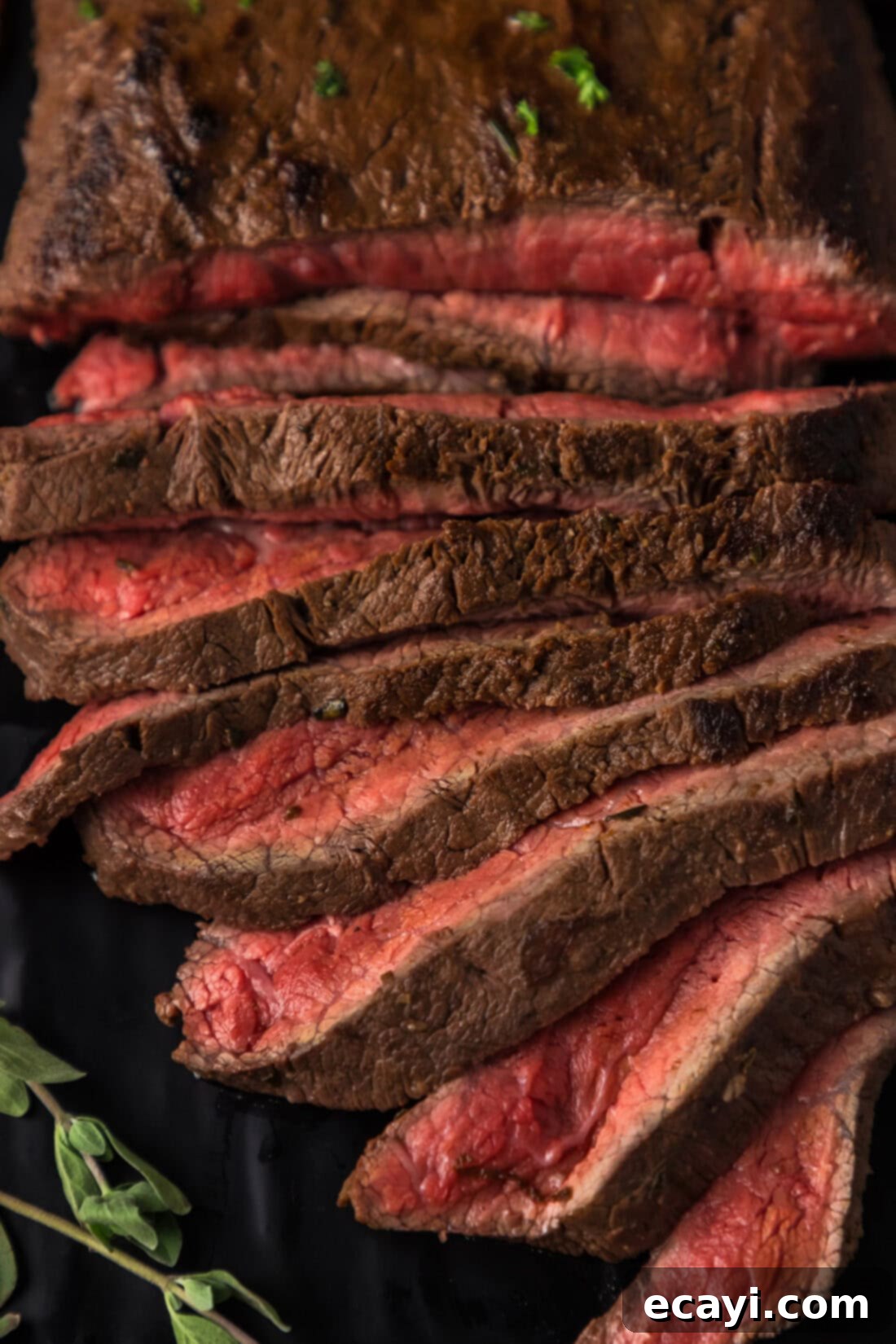
Delectable Serving Suggestions
Once your perfectly cooked flat iron steak has rested, remember to slice it against the grain into thin, manageable pieces. This simple technique dramatically enhances its tenderness, making every bite a delight. The versatility of flat iron steak means it pairs beautifully with a wide array of accompaniments, allowing you to tailor your meal to any occasion.
For an authentic and vibrant flavor explosion, generously top your sliced steak with a heaping scoop of fresh chimichurri sauce. The bright, herbaceous, and tangy notes of chimichurri cut through the richness of the beef, creating an incredibly balanced and refreshing combination that truly elevates the dish. Other excellent sauce options include a creamy blue cheese sauce, a savory mushroom gravy, or a classic peppercorn sauce.
To round out your meal, consider pairing this succulent flat iron steak with hearty and flavorful side dishes. Roasted vegetables like crispy potatoes, tender carrots, vibrant asparagus, savory broccoli, or crisp green beans are always a fantastic choice. For a more indulgent option, a garlic butter pasta or a creamy risotto makes a luxurious accompaniment. If you prefer something lighter, a fresh, leafy salad with a zesty vinaigrette provides a refreshing contrast. Enjoy every tender, flavorful bite!
Explore More Steak Recipes
If you’re a steak enthusiast, don’t stop here! There are countless ways to prepare this beloved cut of meat. Broaden your culinary horizons and master different techniques with these additional steak recipes:
- Grilled Steak: For that classic char and smoky flavor, perfect for outdoor cooking.
- Air Fryer Steak: A quick and efficient method for a tender steak with minimal fuss.
- Sous Vide Steak: Achieve unparalleled precision and tenderness with this water bath technique, followed by a quick sear.
- Smoked Ribeye Steak: Infuse your steak with deep, complex smoky flavors for a truly unique experience.
I love to bake and cook and share my kitchen experience with all of you! Remembering to come back each day can be tough, that’s why I offer a convenient newsletter every time a new recipe posts. Simply subscribe and start receiving your free daily recipes!
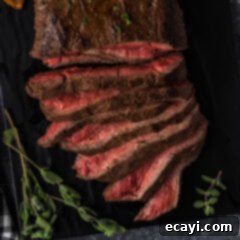
Flat Iron Steak
IMPORTANT – There are often Frequently Asked Questions within the blog post that you may find helpful. Simply scroll back up to read them!
Print It
Pin It
Rate It
Save ItSaved!
Ingredients
- 1 ½ pounds flat iron steak
- 2 Tablespoons olive oil for the skillet
Marinade
- 1 Tablespoon minced garlic
- 1 Tablespoon chopped fresh rosemary
- 2 teaspoons garlic salt
- 1 ½ teaspoons chili powder
- 2 teaspoons dry mustard powder
- 3 Tablespoons Dijon mustard
- ¼ cup chopped green onion green part only
- ½ cup dry red wine such as cabernet
Things You’ll Need
-
Gallon sized zip top bag
-
Oven proof skillet
Before You Begin
- For the red wine, you can purchase single-serve containers or mini bottles from the grocery or liquor store. No need to buy a whole bottle, unless you plan to enjoy some with your meal!
- Flat iron steak, also known as a “top blade steak,” is a relatively tender cut of beef from the shoulder. Ensure you pat the meat dry with paper towels before searing; this is crucial for developing a beautiful, flavorful crust.
Instructions
-
Preheat oven to 400 F (200 C).
-
Place flat iron steak into a gallon zipper plastic bag.
-
Combine all marinade ingredients and stir together well. Pour into the bag with the steak, ensuring it’s fully coated.
-
Marinate in the fridge for 3 hours or up to overnight. Allow to sit out at room temperature for about an hour before cooking. Remove from marinade and pat thoroughly dry with paper towels.
-
Heat olive oil in an oven-proof skillet over medium-high heat until shimmering. Add the dried steak to the skillet and sear on both sides, about 3-4 minutes per side, for a deep crust.
-
Move skillet to the oven and bake for 5-10 minutes. (5 minutes for medium-rare at 130-135F; 10 minutes for medium at 135-140F).
-
Remove steak to a cutting board and tent loosely with foil. Allow to rest for 10 minutes before slicing against the grain and serving.
Expert Tips & FAQs
- Store any cooled leftover steak in an air-tight container kept in the refrigerator for up to 4 days.
- Reheating steak can be tricky to avoid drying it out. I suggest doing it low and slow in the oven. Preheat the oven to 250F. Place a wire rack over a baking sheet and add the steak on top to allow hot air to circulate. Heat until warmed through, around 15-20 minutes.
- Always slice flat iron steak against the grain to maximize its tenderness. This makes a noticeable difference in texture!
- For accurate doneness, use a meat thermometer. The temperature will rise a few degrees after removing the steak from the oven (carryover cooking).
Nutrition
The recipes on this blog are tested with a conventional gas oven and gas stovetop. It’s important to note that some ovens, especially as they age, can cook and bake inconsistently. Using an inexpensive oven thermometer can assure you that your oven is truly heating to the proper temperature. If you use a toaster oven or countertop oven, please keep in mind that they may not distribute heat the same as a conventional full sized oven and you may need to adjust your cooking/baking times. In the case of recipes made with a pressure cooker, air fryer, slow cooker, or other appliance, a link to the appliances we use is listed within each respective recipe. For baking recipes where measurements are given by weight, please note that results may not be the same if cups are used instead, and we can’t guarantee success with that method.
